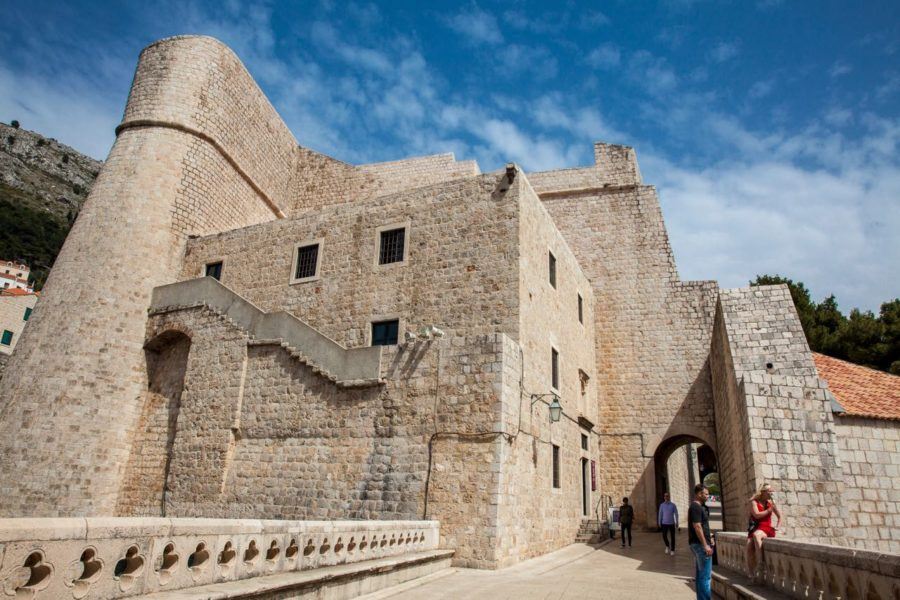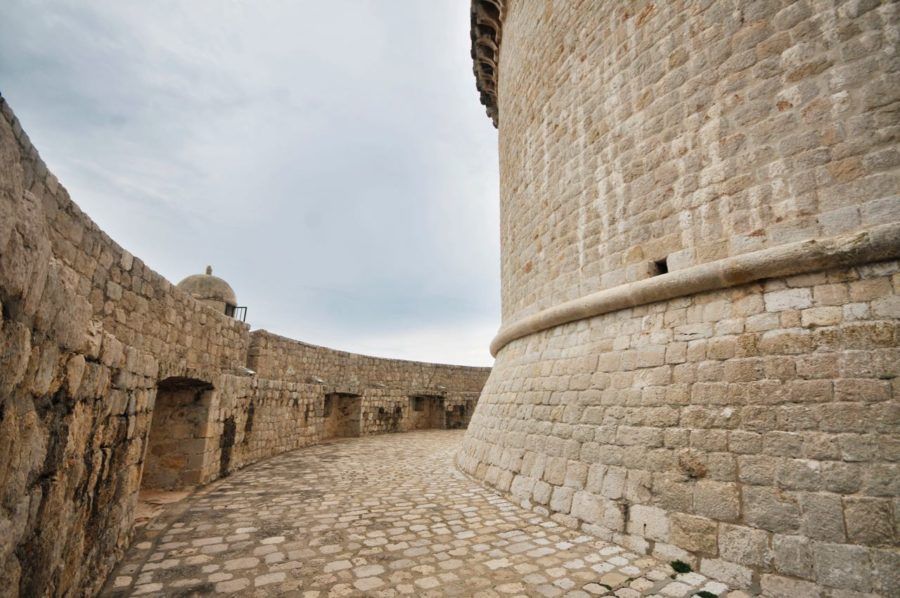Here are my best tips for you to get the most out of walking the walls of Dubrovnik., Croatia’s most famous UNESCO World Heritage Site. I have covered all the info you need about the Dubrovnik City Walls, including the entrance fee and the best time of year to see these defensive walls.

Without a doubt, one of the most famous, if not THE most famous, thing to do in Dubrovnik is to walk the ancient Dubrovnik walls. When you see the walled old city in person, it’s not hard to understand why. This is where you’ll get a bird’s eye view right over the city and the Adriatic Sea; it’s a sight that will stay with you forever.
But it’s also true that you need some information to help your visit go without a hitch. I made a mistake on my first time going at midday in peak season – a huge mistake.
So, the first thing I want you to know is about the heat. The city walls are extremely hot and crowded during the peak summer months. Remember to take a hat and some water with you, and always wear sunscreen. If you can, it’s best to go early in the day to beat the LARGE crowds. But no matter what you do during July and August when Dubrovnik is at its busiest (and worst if you ask me), you’ll encounter many other people trying to do the same thing as you.
In essence, you need to make peace with the fact that the Dubrovnik walls will be crowded from opening to closing in summer.
Skip Ahead To My Advice Here!
What Are The Dubrovnik City Walls

The walls of Dubrovnik run around the perimeter of the Old Tower, and they’re the number one spot for visitors to the area. Historically, the walls were built to defend the city from invaders heading over the Adriatic Sea, with ramparts constructed on the outer city edge right into the mountains as early as 1272. The walls you see today were built between the 13th and 17th centuries.
The good news is that the walls are in fantastic shape considering their age, and you can walk the entire length of them, which covers 2km. Depending on how fast you walk, the crowds you encounter, and how many selfies you stop for, the walk will take you about 1.5 to 2 hours.
What You See While On The Dubrovnik Walls

So, what will you see while walking the Dubrovnik city walls?
Unmatched breathtaking views! That’s what.
You will undoubtedly need your camera for this one thing, so make sure you clear plenty of space and get ready to be wowed.
You can choose to do a guided walking tour, which means a local guide will tell you more about what you’re seeing and the historical importance, but if you prefer to go at your own speed, you can walk yourself, with no problems.

The main entrance is at Great Onofrio’s Fountain, and from there, you’ll climb some stone stairs to give you the first glimpse at the fantastic view that awaits you. You can see right over the Old Town of Dubrovnik, even some hidden streets you might not know existed. You can also see the Adriatic and the beautiful island of Lokrum far over. You can check out countless monuments along the way, and your ticket also includes a visit to Lovrijenac Fortress.
If you’re a fan of Game of Thrones, you’ll also easily recognize some scenes from the show, particularly The King’s Landing.
Brands We Use And Trust
Dubrovnik City Wall Tickets

Prices vary depending on the month. From March to October, an adult ticket is 35 euros, and a child under 18 ticket is 15 euros. From November to February, an adult ticket is 15 euros, and children until 18 will pay 5 euros. As before, your ticket also includes entry to Lovrijenac Fortress.
If possible, it’s advisable to book your ticket online during the summer months; otherwise, you’ll find yourself in a long queue just waiting to get a ticket. If you purchase the Dubrovnik Pass, you can enter the city walls as part of your pass at no extra charge.
However, if you pay on the day, you can pay in euros or with a credit card. You will see the ticket office directly in front of you. The main entrance is across from Great Onofrio’s Fountain, on the Stradun from Pile Gate.
Note: Croatian kunas are no longer used as of January 2023. All proceeds from the sale of entrance tickets for the city walls go to the Society of Friends of Dubrovnik Antiquities, which maintains these historic structures.
If you’re arriving via a cruise or from the port, you may find that you will be transported to the harbor in the Old Town via a boat. Alternatively, take a bus from the port to the Old Town and wait until the last stop. From there, you turn right until you see the main entrance for the walls.

The city walls are open all year around, except for Christmas Day, but opening times do vary:
- January and March: 10 A.M. until 3 P.M.
- April & May: 10 A.M. until 3 P.M.
- June & July: 8 A.M. until 7.30 P.M.
- Aug & Sept: 8 A.M. until 6.30 P.M.
- October: 8 A.M. – 5.30 P.M.
- November & Dec: 10 A.M. until 3 P.M.
Buza Bar
Buza Bar in Dubrovnik is one of those spots that’s all about location, location, location. Perched on the cliffs just outside the city walls, it offers a stunning view of the Adriatic Sea that’s hard to beat. Think of it as the ultimate chill-out zone where you can grab a drink, soak up some sun, and watch the world go by.
Back in 2008, in a moment of youthful bravado, as seen in this very blurry photo, I managed to find on an old USB – I actually jumped off the walls near Buza Bar into the sea.

Looking back, it was a bit of a wild move (and not something I’d recommend!), but it’s a testament to the bar’s adventurous spirit. These days, I’d say the best way to enjoy Buza Bar is to settle in with a cold drink and enjoy the views.
Dubrovnik Forts
Dubrovnik, renowned for its well-preserved medieval walls and fortresses, is home to several significant forts, each with its own history and purpose. People get confused which are which – and which ones are on the walls and which are situated separately. Let me explain:
Fort Bokar (Bokar Fortress)

- Fort Bokar is considered to be amongst the world’s oldest casemate fortresses (a type of fortification with gun emplacements)
- It’s situated on the southwestern corner of the city’s walls and was designed to defend the town’s main gate, Pile Gate, and its bridge
- The fortress is a crucial example of harmonious and functional fortification architecture and offers spectacular views of the sea and the nearby Fort Lovrijenac
Fort Revelin

- Fort Revelin is located outside the eastern city walls. It was built in the 16th century as a separate fortress to provide an additional layer of defense, particularly against the Venetians
- This fortress was constructed to protect the eastern land approach to the city and the bridge leading to Ploče Gate
- Today, Fort Revelin houses a Cultural History Museum and is also known for hosting concerts and nightlife events
Fort St. John (St. Ivan Fortress)

- This fortress is a crucial part of the city’s defense system, located at the southeastern part of the Old Town – not on the city wall walk
- It was initially built in the 14th century but underwent significant modifications in later centuries
- Fort St. John protected the city’s harbor and was equipped with a chain that could be raised to block off the harbor entrance
- Today, it houses the Maritime Museum and the Aquarium
Fort Lovrijenac (St. Lawrence Fortress)
- This fortress is located outside the western wall of the city. It stands on a 37-meter-high sheer rock overlooking the sea.
- Historically, it was a crucial defense point against attacks, particularly from the Venetians. It’s often called “Dubrovnik’s Gibraltar.”
- The fort’s triangular shape, with three terraces, features walls that are up to 12 meters thick on the seaward side but much thinner on the side facing the city, symbolizing the trust Dubrovnik placed in its citizens
- Today, it’s a popular venue for plays and performances, especially during the Dubrovnik Summer Festival
Best Place For Photos On The Walls

If you ask me. Minceta Tower is the top place for photos in the entire old town.
This is the highest point and a key feature of Dubrovnik’s renowned city walls and stands as a symbol of the city’s historic fortitude.
Initially constructed in 1319, the tower underwent significant enhancements under the guidance of the Florentine architect Michelozzo di Bartolomeo and was completed by local architect Juraj Dalmatinac (Juraj of Dalmatia) in 1464. Its massive, round structure with a distinctive Gothic-Renaissance crown was strategically designed for defense, serving as an observation post to guard against invaders.
Best Time To Walk The Walls Of Dubrovnik

The best time to walk the walls of Dubrovnik, Croatia, is during the spring (April to June) or fall (September to October). These periods offer several advantages:
- Pleasant Weather: Spring and fall in Dubrovnik are known for their comfortable temperatures, typically ranging from 15°C to 25°C (59°F to 77°F). This mild weather is ideal for outdoor activities like walking the city walls
- Less Crowded: Summer, especially July and August, is the peak tourist season in Dubrovnik. By choosing spring or fall, you’ll encounter fewer tourists, which makes for a more relaxed and enjoyable experience on the walls
- Better Prices: accommodation and other tourist services often have lower prices in the shoulder season (spring and fall) compared to the peak summer months
- Stunning Views: both spring and fall offer clear skies and excellent visibility, enhancing the best views from the walls
It’s also important to consider the opening hours of the walls, which can vary seasonally, and to check for any temporary closures or changes due to maintenance or special events. Early morning or late afternoon are often recommended times for the walk to avoid the midday sun and to enjoy the walls in softer light, which is especially beautiful for photography.
If you can only visit Dubrovnik and walk its walls in the summer:
Avoid the intense midday heat and the larger crowds, and plan to walk the walls either early in the morning or later in the afternoon. The walls typically open at 8 A.M., so starting your walk around this time is a good idea. Alternatively, going later in the afternoon will allow you to experience the walls in the softer light before sunset.
Are the city walls in Dubrovnik free?
No, however, ticket prices do include entry to Lovrijenac Fortress and vary depending on the season.
- March to October: adult ticket – 35 euros; child under 18 ticket – 15 euros
- November to February: adult ticket – 15 euros, child under 18 ticket – 5 euros
How long does it take to walk the city walls?
Plan on about 1-2 hours
When are Dubrovnik’s city walls open?
The city walls are open all year around, except for Christmas Day, but opening times do vary:
- January and March: 10 A.M. until 3 P.M.
- April & May: 10 A.M. until 3 P.M.
- June & July: 8 A.M. until 7.30 P.M.
- Aug & Sept: 8 A.M. until 6.30 P.M.
- October: 8 A.M. – 5.30 P.M.
- November & Dec: 10 A.M. until 3 P.M.
Can I walk the city wall by myself, or do I need to take a tour?
You can either walk the walls at your own pace or join a guided tour.
How high are the Dubrovnik city walls?
These high walls are high! Approximately 25 meters high, in fact. Be careful; each year, someone falls and lands in the ICU like this woman.
Where are the Dubrovnik city walls?
The walls of Dubrovnik run around the perimeter of the Old Tower.
Is it worth it to walk the city walls?
Absolutely! Views are incredible, and they’re the number one spot for visitors to the area.
When is the best time to arrive at the city walls?
Early morning is ideal as you will beat most of the crowds, especially cruise ships.
What should I wear and bring when walking Dubrovnik’s city walls?
It’s very sunny, so bring a hat, sunscreen and water.
I know that you will love walking the Dubrovnik’s walls as much as I have over the years. When you are at the top of the walls, imagine you are in the Middle Ages in Dubrovnik (known then as Ragusa), and the Ottoman Empire is on its way…..
- Things To Do When Docking At Dubrovnik’s Cruise Port
- Where To Stay In Dubrovnik
- Dubrovnik Villas, Hotels & Apartments With Pools
- Where To Go Camping In Dubrovnik
- Best Restaurants In Dubrovnik
- How To Beat The Crowds In Dubrovnik
- Dubrovnik Beaches To Keep You Cool
- Best Things To Do In Dubrovnik
- Dubrovnik Cable Car Guide
- Winter In Dubrovnik? Yes Indeed!
- How Many Days In Dubrovnik Is Enough?
- What Language Is Spoken In Croatia

